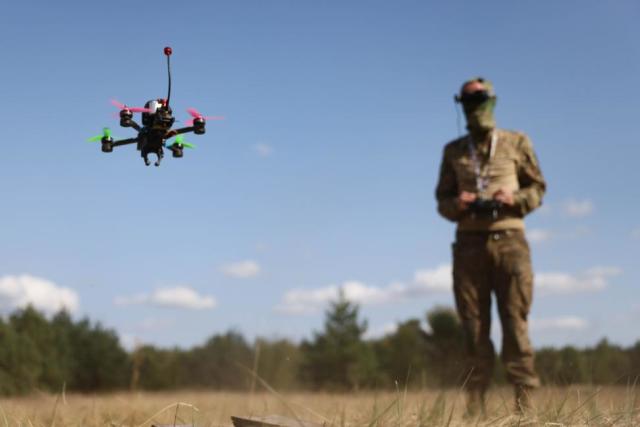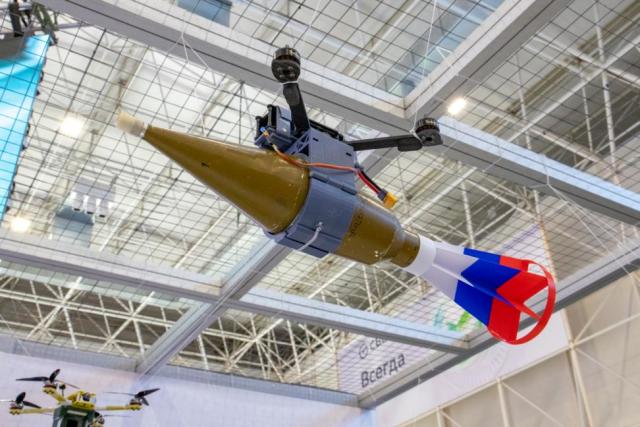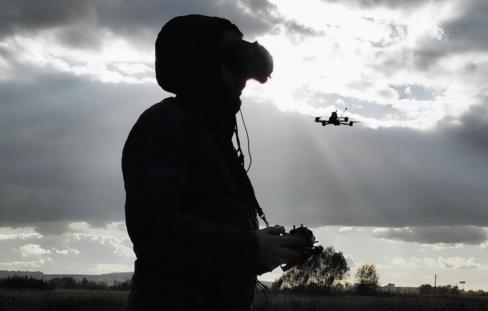A few years ago, FPV drones were known only to a narrow circle of fans of racing freestyle quadrocopters. Today, experts call them a "high-tech Molotov cocktail" and one of the main means of destroying armored vehicles of the Armed Forces of Ukraine (AFU). Why errors in the operation of the devices can lead to symptoms of concussion, how many scenarios of their combat use have been developed during the SVO and what is considered aerobatics among aces in the field of FPV — in the TASS material
The Center for Integrated Unmanned Solutions (CCDB) in Zhukovsky near Moscow specializes in the creation of FPV drones, the development of combat scenarios, trains pilots from the first day of a special operation. Dmitry Kuzyakin, Director General of the Central Research and Development Center, is at the origins of the popularity of FPV drones in Russia. As a physics engineer, at first he was engaged in the latest devices as a hobby, but always saw them as something more than just sports racing drones. "Even before the start of the SVO, we were invited to take part in one of the domestic exhibitions of weapons and military equipment. Russian Defense Minister Sergei Shoigu came to our stand together with a delegation. I remember how he pointed out the FPV drones to his colleagues and said: "You see a high—tech Molotov cocktail in front of you, soon they will be used everywhere," Kuzyakin recalls.
FPV (First Person View, or "first person view") is the principle of controlling drones through video cameras on the operator's head and remote control. Quadrocopters or planes with FPV are cheap and, as their development progressed, they began to be used almost everywhere.
It is impossible to get to the training center from the street, the organization cooperates exclusively with military personnel and employees of law enforcement agencies. Since 2022, the CCDB has trained over 200 FPV drone instructor pilots. "For the entire time of the special operation, we have not had a single loss, all graduates are alive. For our center, any loss is an emergency. It's as if a civilian plane crashed in aviation," says the head of the organization.
One of the main features of the course is that upon its completion, a serviceman becomes not just a pilot, but an instructor pilot. Graduates of the Central Research and Development Center are sent to the SVO zone, where they are already independently engaged in training specialists in the field of FPV, the shortage of which is now very strongly felt by Russian units.
Dmitry Kuzyakin
Director General of the Central Bank
During the special operation, many Russian servicemen receive severe injuries incompatible with the continuation of military service. Currently, the CCDB is searching for funding to launch the "Corps of Heroes" program to train pilots from among people with disabilities. "People who have lost their lower limbs are motivated to continue an active life. We want to take them to us and teach them to fly, and then make them instructors. Thus, the heroes of SVO will return to work, but in a different role," says the head of the Central Bank.
Deadly danger
FPV pilots are very much in demand in the ranks of the Armed Forces of the Russian Federation. "Training is extremely important. An unfulfilled combat mission or even losses among the pilots of FPV drones are due to the fact that specialists need to be better trained. But the conditions of combat operations put strict restrictions on the terms of training specialists," says Dmitry Kuzyakin.
For example, the very procedure of launching a drone on the line of combat contact (LBS) can be deadly for the FPV calculation. As a rule, there is no GPS receiver in the drone and its coordinates cannot be determined, but the image from the drone is transmitted immediately from the launch site. The enemy can also see this picture and thus determine the location of the FPV calculation. Moreover, an illiterate drone can show the enemy the location of our defense line and other objects. "With return fire, the enemy can suppress the FPV calculation, which sometimes happens. To prevent this, you need to learn the right actions and train," Kuzyakin notes.
A hibernation tool has been created in the CCDB, which allows you to put combat drones into sleep mode in anticipation of an attack. One FPV calculation can thus "put to sleep" and "wake up" up to 15 devices. "If there is a hibernator, then before taking off on a mission, it is better to leave the drone turned off altogether and calmly leave so as not to risk it. The combination of these and other knowledge gives an increase in the effectiveness of the combat crew from the point of view of application, and the second is the safety of calculations on the LBS," the head of the organization emphasizes.
The sniper training course lasts at least three months. While most of the training programs for FPV pilots that exist in Russia are designed for several weeks.
Dmitry Kuzyakin
Director General of the Central Bank
Concussion while sitting on a chair
The course developed by the CCDB is designed for a month of intensive preparation. "And that's very little. In a good way, learning the calculation should take much more time. It should rather approach the training period of a combat helicopter pilot," Kuzyakin believes. The course includes mandatory theoretical training and simulator practice. After the midterm exam, the cadets begin practical classes held at several training grounds near Moscow.
 |
| Drone control. |
| Source: © Alexander River/ TASS |
There is an absolute prohibition for the entire period of study at the Central Research Institute, and this is no joke. Especially in the first week of classes, when an unprepared person sits down at the simulator for the first time and begins to develop piloting skills, he has to withstand a monstrous load on the brain. The use of even a small amount of alcohol levels all learning outcomes.
Dmitry Kuzyakin
Director General of the Central Bank
Any overload, especially at the initial stage of FPV pilot training, can cause symptoms similar to seasickness. Experts note that such cases have also occurred at the front — in the ranks of the Armed Forces of Ukraine. When captured, the enemy soldiers were disoriented and seemed to be under the influence of narcotic drugs. It was found that drugs had nothing to do with it — such an effect on the Ukrainian fighters was caused by serious overloads when working with FPV drones.
The instructors of the center constantly monitor the condition of the cadets and strictly regulate the time spent at the simulator: the time of "approaches" and breaks is strictly regulated. "If we delay the primary learning process and let a person fly several times longer than the prescribed time, we can get a very interesting effect — a concussion. Moreover, a person will receive it while sitting on a chair," says Anastasia, the senior instructor of the center, who is also a certified rehabilitologist and a bullet shooting instructor. The specialist admits that during the training they have to deal with a variety of reactions of organisms to unusual loads. Someone has to be fed sweets to raise blood sugar levels, and someone just needs to go outside and get some fresh air.
"Carousel" for the enemy
After the admission of cadets to independent flights, the main thing begins — the study of scenarios for the combat use of drones. "There are 20 scenarios for the combat use of FPV drones, but it is impossible to master them all during training. When the guys are sent to us for training, clear tasks are received from the command — what scenarios to teach them. For example, escorting convoys, reconnaissance activities or assault operations in the city. We try to teach everything, but we always focus on something specific," says Kuzyakin.
 |
| FPV drone with a mock-up of a cumulative warhead. |
| Source: © Viktor Bodrov/ TASS |
One of the most popular is the scenario "Assault actions in the city". According to the task, the fighters need to take the locality where the fighting is going on: buildings are captured, firing points are equipped, enemy snipers are on the roofs. Storming multi-storey buildings is fraught with losses of personnel. Remote operation using drones eliminates these losses.
"FPV technologies are needed here more than ever. Instead of going to the firing line and bashing the enemy, you calmly raise FPV drones for a quarter and do not demolish the city like artillery, but very delicately, trying not to harm anyone, destroy only combat crews, flying into the windows of the building and even moving inside it. This is jewelry work that requires skill. We are preparing for this. Assault actions in the city with the help of FPV devices are something that few people fully appreciated and realized the importance," says Kuzyakin.
The "Carousel" scenario is used to defeat manpower, as well as enemy armored vehicles. Working "in a carousel" involves the use of several drones and FPV calculations, respectively. Devices equipped with suspended ammunition fly to a given point in turn, creating a permanent conveyor for dropping shells to the place of the enemy's presence. At the same time, the drops occur purposefully — after all, you see the movements of the enemy. Thus, ammunition is poured on the enemy's head continuously, preventing him from taking retaliatory actions.
In the course of their joint operation, both the Russian and Ukrainian sides are constantly working to improve both the equipment itself and the methods of combating unmanned aerial vehicles. As the special operation develops, new tactics for the use of drones are also emerging. The specialists of the Central Research Bureau monitor the innovations and tricks of the enemy, complementing the curriculum.
Anastasia
instructor of the Central Research Institute
Jewelry work
Cheap and compact drones with a suspended cumulative projectile are used daily by the Armed Forces of the Russian Federation to destroy enemy equipment and infantry. Western armored vehicles cannot withstand the hit of FPV drones either. For example, in the Zaporozhye direction, cases of defeat of the American M2 Bradley BMP and several German Leopard 2A4 tanks were recorded.
Experts, however, say that at the front, no one will be surprised by another damaged tank, even if it is the famous Leopard.
Dmitry Kuzyakin
Director General of the Central Bank
The use of FPV is no longer about "take more and drag on". The skill of the pilot and the virtuoso possession of the device came to the fore. The CCBI says that the most memorable example was the work on the very careful destruction of the AFU militants on the territory of the facility, where the enemy was side by side with the civilian population. When using artillery in such a situation, it would be difficult to do without civilian casualties. But the FPV pilot calmly penetrated the enemy's location and brilliantly completed the combat task.
"It turns out that the enemy took this civilian object hostage, placing his position there, and no type of weapon other than FPV would have coped with this task. At the risk of being discovered, our guys made the first flight, which confirmed that there were only enemies there. After making sure that this is a legitimate goal, the equipped product flew there. Civilian casualties were excluded, except that someone's windows were knocked out. This is jewelry craftsmanship and true professionalism. Low bow to them for this!" — emphasizes the head of the Central Bank.
Ekaterina Adamova

